Mahsa Amini Death In Custody Needs No Apology - Iranian Hardliner
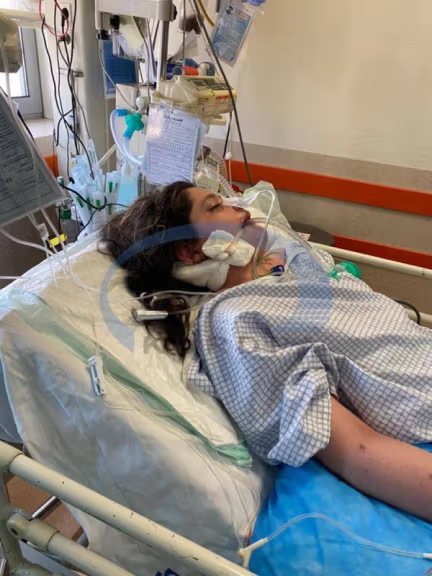
One of Iran’s hardline conservatives has slammed officials for apologizing for Mahsa Amini’s death in custody of hijab police.

One of Iran’s hardline conservatives has slammed officials for apologizing for Mahsa Amini’s death in custody of hijab police.
In an interview on state TV, Mohammad Sadegh Koushki, a Tehran University professor, said apologies for Amini’s highly publicized death are an "incorrect move."
Koushki said, "What prompts the need for apologies? [The death of Mahsa Amini] was an unintended outcome. It is indeed the subsequent apologies of certain high-ranking figures that have inadvertently exacerbated the situation."
He added that fatalities to detainees during detention and interrogation are inherently "very natural."
Currently, no officials from the Islamic Republic have formally extended apologies for Mahsa Amini's death or for the loss of numerous other lives even in the wake of nationwide protests.
During a televised interview, Mohammad Bagher Ghalibaf, the Speaker of the Parliament, indicated that he had formally requested an apology from the law enforcement forces. However, no formal apology has been issued to date.
In a conversation with Mahsa Amini's family, President Ebrahim Raisi, abstained from issuing an apology. Instead, he committed to clarifying the full "dimensions" of the circumstances surrounding Amini's death—an assurance that, as of the present date, remains unfulfilled.
Mahsa Amini's death in custody was not an isolated incident. Sattar Beheshti, an outspoken blogger, and Zahra Kazemi, an Iranian-Canadian photographer, and many others, also lost their lives as a result of aggressive interrogations carried out by agents of the Islamic Republic. The true number of deaths has not been not officially recorded.
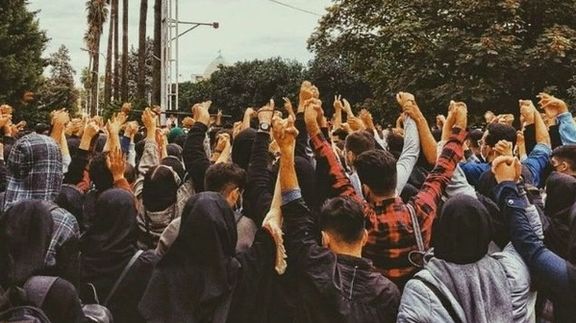
Iran's Ministry of Intelligence has interrogated students from Allameh Tabatabai University in Tehran as the anniversary of Mahsa Amini’s death approaches.
Students from several universities, including Tabatabai, Beheshti, Khajeh Nasir, Tehran, Amirkabir, and Ferdowsi, have been summoned by the authorities ahead of the September anniversary of Amini’s death. These summonses come amidst escalating pressure on student activists affiliated with the protest movement and have prompted concerns among student communities and human rights advocates.
A Telegram channel known as ‘United Students’ revealed that out of a group of 15 students from Allameh University who had previously been contacted by intelligence agencies, six have been summoned to the Ministry of Intelligence where they underwent extensive questioning.
The interrogations, some spanning up to five hours, were allegedly based on university security reports, with a specific focus on protests that transpired on March 7. These protests have been linked to concerns surrounding the serial poisoning of school students.
During these interrogations, the six students reportedly faced threats of "detention and judicial action”.
Simultaneously, student activists from Esfahan University released a comprehensive report documenting instances of actions and suppression throughout the ‘Women, Life, Freedom’ movement. Approximately 500 students from Esfahan and Esfahan University of Medical Sciences were subjected to summons and interrogations by the Ministry of Intelligence between September and November.
As the one-year anniversary of the widespread protests in Iranian universities approaches, there has been a wave of anonymous phone calls to students and subsequent summoning by security entities.
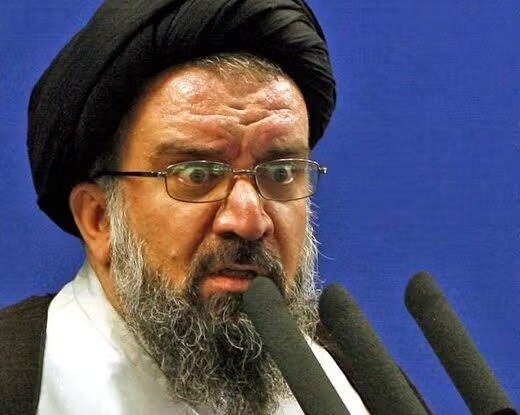
A member of the Iranian Assembly of Experts issued a stern threat against any future protestors, saying that they would be met with forceful suppression.
Ahmad Khatami's remarks were made in response to last year's nationwide demonstrations after the death of Mahsa Amini in police custody, which he said were a "failure".
Addressing the Islamic Revolutionary Guard Corps (IRGC) forces and police units on Monday, Khatami emphasized the imperative of safeguarding the Islamic Republic. “Preserving the Islamic Republic is one of our obligations,” he said, as well as praising the Basij militia forces for their actions in the previous protests. "Basij militia forces were persecuted during these events and sacrificed their lives so that the Islamic Republic would pass through this stage," Khatami said.
However, Khatami's statements sharply contrast with reports from independent media outlets and human rights organizations saying that Basij forces, in particular, were responsible for violent aggression against the protests. The Women, Life, Freedom protests sparked by the death of Mahsa Amini, were met with severe and deadly oppression by the security and military forces of the Islamic Republic.
Although a precise tally of casualties is unclear, some media sources have verified and disclosed the identities of 373 individuals who lost their lives. Meanwhile, human rights entities such as the Iran Human Rights Organization and the US-based Human Rights Activists News Agency (HRANA) have placed the estimated death toll at over 500.
In his address, Ahmad Khatami summarized the various challenges that have beset the Islamic Republic over the past four decades. He remarked, "Many dangers have threatened the Islamic Republic during the past four decades and many of these dangers have been the danger of overthrow.”

Journalist Nazila Maroufian, who was released on bail just days ago, has been arrested again and detained in Qarchak prison.
The journalist, who is also a student at Allameh Tabatabai University in Tehran, was arrested in July following a summons to the Prosecutor's Office at Evin prison.
After being released on bail on Sunday, she went to a police station to retrieve her mobile phone and was allegedly attacked by law enforcement officers. A witness reported that an officer struck Maroufian on the back of her head. Maroufian’s mother, who was with her, compared her daughter's treatment to the tragic case of Mahsa Amini, who died while in the custody of the morality police. The officer replied, "Yes, just like we killed her, we will kill this one as well."
Both mother and daughter were arrested and detained although Maroufian's mother was later released. The journalist herself was transferred to a quarantine ward within Qarchak prison, south of Tehran, based on a temporary arrest warrant.
Her initial arrest came after security agents from the Ministry of Intelligence raided Maroufian's home and summoned her to the prosecutor's office.
Maroufian was previously employed by the moderate Iranian news website Rouydad 24, which had been a reliable source of news about developments in Iran. In March, the Iranian regime temporarily blocked access to the website after it published an interview with Amjad Amini, the father of Mahsa (Zina) Amini.

Iranian poultry farmers gathered outside the Ministry of Agriculture on Saturday to protest government's failure to deliver essential animal feed.
Despite having paid for soybean and corn inputs over a year ago, the group of angry farmers from poultry production units in Qazvin province, have not received their orders from the Ministry of Agriculture, nor have they been reimbursed. Their accrued losses over this period amount to 100,000 billion rials ($200 million).
The protestors held placards berating the Ministry for placing them in a crippling financial situation and that they had reached breaking point.
They also raised additional concerns at the practice of government agencies buying their produced poultry at slashed prices using coercive measures and threats.
Supply of livestock and poultry production inputs is a systemic and ongoing issue. It has been more than a year since subsidies were reduced and cuts were made to the allocation of discounted foreign currency to essential goods importers. This has resulted in a disturbing cycle of shortages, delivery delays, and outright unavailability of necessary production inputs, negatively impacting the livelihoods of the country's livestock and poultry producers.

Iranians held a demonstration in the northwestern city of Tabriz on Saturday to protest mismanagement that has led to the disappearance of Lake Urmia.
The protesters gathered outside the provincial office of Iran’s Natural Resources and Watershed Management Organization, demanding the reopening of dams on rivers that feed the lake to resuscitate the dying hypersaline body of water.
Located between the provinces of East Azarbaijan and West Azarbaijan in northwestern Iran, Lake Urmia (Orumiyeh) was the largest lake in the Middle East and the sixth-largest saltwater lake on Earth with an original surface area of 5,200 square kilometers in the 1970s, or 2,000 square miles. It had shrunk to 700 sq km by 2013. The lake began shrinking in the 1980s due to water mismanagement and climate change.
During the demonstration, people chanted slogans such as "Lake Urmia is thirsty" and "Break the dams, fill Lake Urmia." In July 2022, a protest was also held and police arrested an unknown number of activists.
Once a thriving tourist hotspot with bustling hotels lining its shores and commercial ferries plying its waters, the lake currently hovers on the brink of utter disappearance. This dire situation is the result of a combination of factors, including prolonged droughts, excessive water consumption by local communities, and the ill-conceived construction of dams along its tributaries, all exacerbated by the regime's neglectful approach.
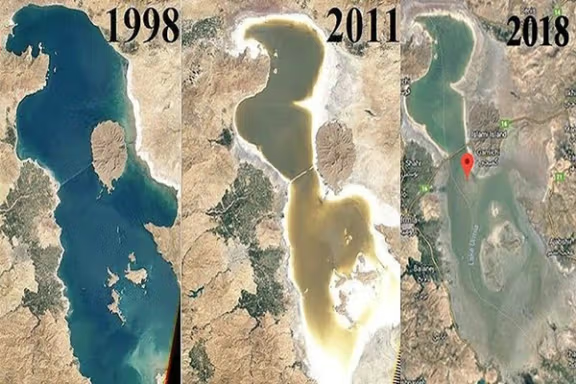
Experts say excessive and illegal groundwater extraction and using the water of the once bountiful Zarrineh Rud − which feeds Urmia Lake − for irrigating apple trees have both contributed to the lake shrinking by nearly 95 percent in volume over the past 20 years. In 2021 alone, more than 100,000 tons of apples of the province’s production went to waste.
Recent images capturing the last gasps of the lake depict a stark portrayal of its complete extinction and the severe environmental repercussions in the region. Nevertheless, regime officials still defend their actions with several phantasmagorical visions.
Ali Salajegheh, a vice president and the head of Iran's Department of Environment Protection, said during his visit to the region that “We hope that with substantial autumn rainfall, the situation of Lake Urmia will improve.”
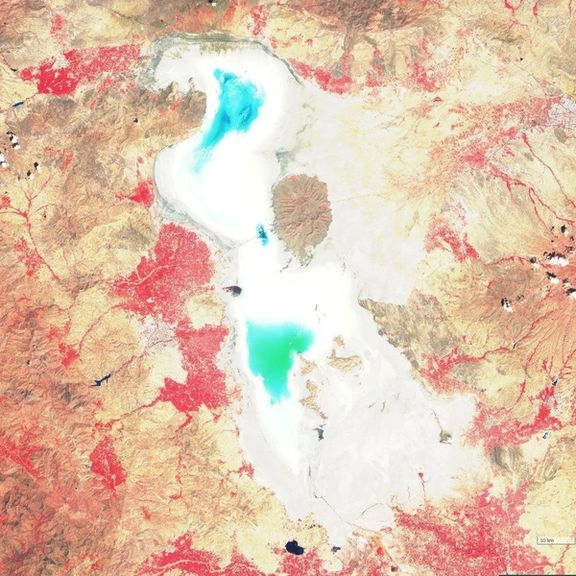
His claims came a day after Ramezan Sharif, the spokesperson of the Islamic Revolutionary Guard Corps (IRGC), described the public concern over the dying lake as an attempt by the critics of the regime to "undermine the authority of the Islamic Republic.” He claimed that "over the past 800 years, several lakes like Lake Urmia have dried up around the world, and these specific climate changes are not unique to Iran."
Fars news agency, affiliated with the Revolutionary Guard, quoted Salman Zaker – representative of the city of Orumiyeh in the parliament -- as saying on Saturday that the private sector can play a constructive role in saving the lake. "This is a demand shared by the public at large, and the government should engage the private sector in this endeavor. Thousands of residents of the region are eager to contribute to saving Lake Urmia by participating in the water transfer project from the Caspian Sea,” he said.
His remarks showed the attitude of regime insiders who make grandiose and baseless statements. Transferring water from the Caspian Sea hundreds of kilometers away would be a herculean task.

“Approximately 28 solutions have been considered for the revival of Lake Urmia," he said, claiming that “The results of the measures taken to revive Lake Urmia may not yet be tangibly evident... However, these actions can gradually lead to positive outcomes for the lake.”
Etemad, one of Tehran's prominent reformist dailies, said in an opinion piece on Saturday that studies indicate even the release of water from all upstream dams cannot revive Lake Urmia. Citing a study by researchers at Tehran’s Sharif University, the article said, "The water level of Lake Urmia on June 3, 2023, reached its lowest recorded level since measurements began, and now the volume of water is even lower than in 2015, the year when the lake's condition was announced as critical.”
In May, the former head of Iran's Environment Protection Organization warned that four million Iranians risk displacement if Lake Urmia dries up. “Transferring the residents of Tabriz to another place requires $500 billion while the cost of reviving the lake is about one billion dollars,” Issa Kalantari said, explaining that the salt dust would be unbearable for residents in Tabriz and its surrounding cities.
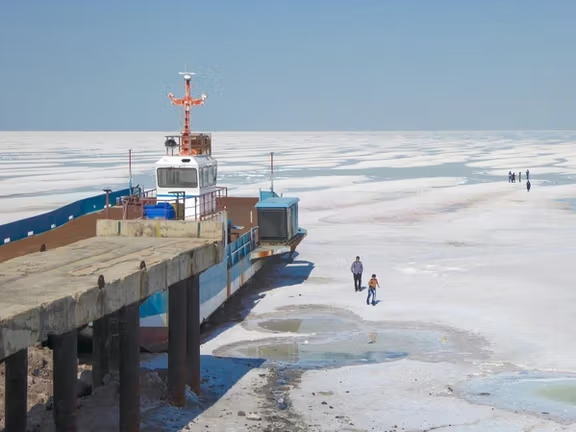
Last year, when the lake had shrunk by 95 percent, he said the fate of the Iranian regime is contingent on saving the lake. If the lake is not restored, it will have security consequences, and no government can survive in the country because it cannot withstand the flood of migration of millions of people who reside in the surrounding regions, he said.
The government of President Hassan Rouhani appropriated 150 trillion rials – in 2014 – equivalent to one billion dollars at the time - for a seven-year plan as well as another $10 million aid by Japan and some other pledges by the United Nations Food and Agriculture Organization (FAO) and the United Nations Development Program (UNDP) to save the lake. It is not clear whether or how the earmarked budgets were spent.